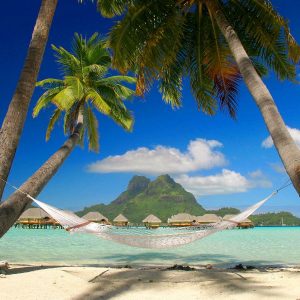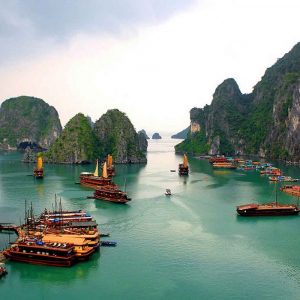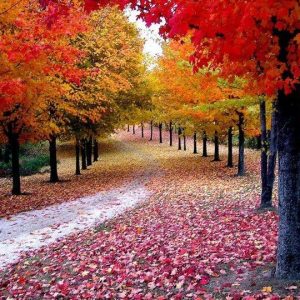Vietnam
Often associated with slim looking smiley women wearing conical hats, Vietnam is located along the eastern edge of Indochina. It has a surface area of 329,314 square kilometers.Vietnam is also known for its seemingly endless and fascinating 3,260 kilometer long coastline; some parts dotted with coconut palms casting their shade, while others appear to disappear in infinity of sand dunes and rugged mountains. Besides the white sandy beaches and tranquil water, Vietnam is also a country that boasts of a rich culture heritage.The old capital of Hue, for example, is a site included on the World Heritage list. It is an amazing country with 82 millions inhabitants including approximately 54 ethnic groups and the Vietnamese are very proud of their 4,000 years of history. The French established a colony in Vietnam that held for almost 100 years. The war with the Americans did much to turn the world’s attention to Vietnam, which remembers the event, either for its brutality or the failure of American power. The Vietnamese people are not only very determined, but also warm and friendly. Vietnam today has reached new heights of prosperity and is open for visitors to visit country at peace.
Archaeological excavations have revealed the existence of humans in what is now Vietnam as early as the Paleolithic age. Homo erectus fossils dating to around 500,000 BC have been found in caves in Lạng Sơn and Nghệ An provinces in northern Vietnam. The oldest Homo sapiens fossils from mainland Southeast Asia are of Middle Pleistocene provenance, and include isolated tooth fragments from Tham Om and Hang Hum. Teeth attributed to Homo sapiens from the Late Pleistocene have also been found at Dong Can, and from the Early Holocene at Mai Da Dieu, Lang Gao and Lang Cuom.
By about 1000 BC, the development of wet-rice cultivation and bronze casting in theMa River and Red River floodplains led to the flourishing of the Đông Sơn culture, notable for its elaborate bronze drums. At this time, the early Vietnamese kingdoms of Văn Lang and Âu Lạc appeared, and the culture’s influence spread to other parts of Southeast Asia, including Maritime Southeast Asia, throughout the first millennium BC.
Government and politics
The Socialist Republic of Vietnam, along with China, Cuba, and Laos, is one of the world’s four remaining one-party socialist states officially espousing communism. Its current state constitution, 2013 Constitution, asserts the central role of the Communist in all organs of government, politics and society. The General of the Communist Party performs numerous key administrative and executive functions, controlling the party’s national organization and state appointments, as well as setting policy. Only political organizations affiliated with or endorsed by the Communist Party are permitted to contest elections in Vietnam. These include the Vietnamese Fatherland Front and worker and unionist parties. Although the state remains officially committed to socialism as its defining creed, its economic policies have grown increasingly capitalist, with The Economist characterizing its leadership as “ardently capitalist communists”.
Legislature
The National Assembly of Vietnam is the unicameral legislature of the state, composed of 498 members. Headed by a Chairman, it is superior to both the executive and judicial branches, with all government ministers being appointed from members of the National Assembly.
Executive
Vietnamese President Trương Tấn Sang with his first lady during theMoscow Victory Day Parade, 9 May 2015
The President of Vietnam is the titular head of state and the nominal commander-in-chief of the military, serving as the Chairman of the Council of Supreme Defense and Security. The Prime Minister of Vietnam is the head of government, presiding over a council of ministers composed of three deputy prime ministers and the heads of 26 ministries and commissions.
Judiciary
The Supreme People’s Court of Vietnam, headed by a Chief Justice, is the country’s highest court of appeal, though it is also answerable to the National Assembly. Beneath the Supreme People’s Court stand the provincial municipal courts and numerous local courts. Military courts possess special jurisdiction in matters of national security. Vietnam maintains the death penalty for numerous offenses; as of February 2014, there are around 700 inmates on death row in Vietnam.
Military
The Vietnam People’s Armed Forces consists of the Vietnam People’s Army, the Vietnam People’s Public Security and the Vietnam Civil Defense Force. The Vietnam People’s Army (VPA) is the official name for the active military services of Vietnam, and is subdivided into the Vietnam People’s Ground Forces, the Vietnam People’s Navy, the Vietnam People’s Air Force, the Vietnam Border Defense Force and the Vietnam Coast Guard. The VPA has an active manpower of around 450,000, but its total strength, including paramilitary forces, may be as high as 5,000,000.[89] In 2011, Vietnam’s military expenditure totalled approximately US$2.48 billion, equivalent to around 2.5% of its 2010 GDP.
Vietnam is located on the eastern Indochina Peninsula between the latitudes 8° and24°N, and the longitudes 102° and 110°E. It covers a total area of approximately 331,210 km2 (127,881 sq mi), making it almost the size of Germany. The combined length of the country’s land boundaries is 4,639 km (2,883 mi), and its coastline is 3,444 km (2,140 mi) long. At its narrowest point in the central Quảng Bình Province, the country is as little as 50 kilometres (31 mi) across, though it widens to around 600 kilometres (370 mi) in the north. Vietnam’s land is mostly hilly and densely forested, with level land covering no more than 20%. Mountains account for 40% of the country’s land area, and tropical forests cover around 42%.
The northern part of the country consists mostly of highlands and the Red River Delta. Phan Xi Păng, located in Lào Cai Province, is the highest mountain in Vietnam, standing 3,143 m (10,312 ft) high. Southern Vietnam is divided into coastal lowlands, the mountains of the Annamite Range, and extensive forests. Comprising five relatively flat plateaus of basalt soil, the highlands account for 16% of the country’s arable land and 22% of its total forested land. The soil in much of southern Vietnam is relatively poor in nutrients.
The Red River Delta, a flat, roughly triangular region covering 15,000 km2(5,792 sq mi), is smaller but more intensely developed and more densely populated than the Mekong River Delta. Once an inlet of the Gulf of Tonkin, it has been filled in over the millennia by riverine alluvial deposits. The delta, covering about 40,000 km2 (15,444 sq mi), is a low-level plain no more than 3 meters (9.8 ft)above sea level at any point. It is criss-crossed by a maze of rivers and canals, which carry so much sediment that the delta advances 60 to 80 meters (196.9 to 262.5 ft) into the sea every year.
Because of differences in latitude and the marked variety in topographical relief, the climate tends to vary considerably from place to place. During the winter or dry season, extending roughly from November to April, the monsoon winds usually blow from the northeast along the Chinese coast and across the Gulf of Tonkin, picking up considerable moisture. Consequently, the winter season in most parts of the country is dry only by comparison with the rainy or summer season. The average annual temperature is generally higher in the plains than in the mountains, and higher in the south than in the north. Temperatures vary less in the southern plains around Ho Chi Minh City and the Mekong Delta, ranging between 21 and 28 °C (69.8 and 82.4 °F) over the course of the year. Seasonal variations in the mountains and plateaus and in the north are much more dramatic, with temperatures varying from 5 °C (41.0 °F) in December and January to 37 °C (98.6 °F) in July and August.
The official national language of Vietnam is Vietnamese (Tiếng Việt), a tonal Mon–Khmer language which is spoken by the majority of the population. In its early history, Vietnamese writing used Chinese characters. In the 13th century, the Vietnamese developed their own set of characters, referred to as Chữ nôm. The folk epic Truyện Kiều (“The Tale of Kieu”, originally known as Đoạn trường tân thanh ) by Nguyễn Du was written in Chữ nôm. Quốc ngữ, the romanized Vietnamese alphabet used for spoken Vietnamese, was developed in the 17th century by the Jesuit Alexandre de Rhodes and several other Catholic missionaries. Quốc ngữ became widely popular and brought literacy to the Vietnamese masses during the French colonial period.
Vietnam’s minority groups speak a variety of languages, including Tày, Mường, Cham, Khmer, Chinese, Nùng, andH’Mông. The Montagnard peoples of the Central Highlands also speak a number of distinct languages. A number ofsign languages have developed in the cities.
The French language, a legacy of colonial rule, is spoken by many educated Vietnamese as a second language, especially among the older generation and those educated in the former South Vietnam, where it was a principal language in administration, education and commerce; Vietnam remains a full member of the Francophonie, and education has revived some interest in the language. Russian – and to a much lesser extent German, Czech and Polish – are known among some Vietnamese whose families had ties with the Soviet bloc during the Cold War. In recent years, as Vietnam’s contacts with Western nations have increased, English has become more popular as a second language. The study of English is now obligatory in most schools, either alongside or in many cases, replacing French. Japanese and Korean have also grown in popularity as Vietnam’s links with other East Asian nations have strengthened.
According to an analysis by the Pew Research Center, in 2010 about 45.3% of the Vietnamese adhere to indigenous religions, 16.4% to Buddhism, 8.2% to Christianity, 0.4% to other faiths, and 29.6% of the population isn’t religious.
According to the General Statistics Office of Vietnam’s report for 1 April 2009, 6.8 million (or 7.9% of the total population) are practicing Buddhists, 5.7 million (6.6%) are Catholics, 1.4 million (1.7%) are adherents of Hòa Hảo, 0.8 million (0.9%) practise Caodaism, and 0.7 million (0.9%) are Protestants. In total, 15,651,467 Vietnamese (18.2%) are formally registered in a religion. According to the 2009 census, while over 10 million people have taken refuge in the Three Jewels of Buddhism, the vast majority of Vietnamese people practice ancestor worshipin some form. According to a 2007 report, 81% of the Vietnamese people do not believe in God.
About 8% of the population are Christians, totalling around six million Roman Catholics and fewer than one million Protestants. Christianity was first introduced to Vietnam by Portuguese and Dutch traders in the 16th and 17th centuries, and was further propagated by French missionaries in the 19th and 20th centuries, and to a lesser extent, by American Protestant missionaries during the Vietnam War, largely among the Montagnards of South Vietnam.
The largest Protestant churches are the Evangelical Church of Vietnam and the Montagnard Evangelical Church. Two-thirds of Vietnam’s Protestants are reportedly members of ethnic minorities. Although a small religious minority, Protestantism is claimed to be the country’s fastest-growing religion, expanding at a rate of 600% in the previous decade.
The Vietnamese government is widely seen as suspicious of Roman Catholicism. This mistrust originated during the 19th century, when some Catholics collaborated with the French colonists in conquering and ruling the country and in helping French attempts to install Catholic emperors, such as in the Lê Văn Khôi revolt of 1833. Furthermore, the Catholic Church’s strongly anti-communist stance has made it an enemy of the Vietnamese state. The Vatican Church is officially banned, and only government-controlled Catholic organisations are permitted. However, the Vatican has attempted to negotiate the opening of diplomatic relations with Vietnam in recent years.
Several other minority faiths exist in Vietnam. A significant number of people are adherents of Caodaism, an indigenous folk religion which has structured itself on the model of the Catholic Church. Sunniand Cham Bani Islam is primarily practiced by the ethnic Cham minority, though there are also a few ethnic Vietnamese adherents in the southwest. In total, there are approximately 70,000 Muslims in Vietnam, while around 50,000 Hindus and a small number of Baha’is are also in evidence.
The Vietnamese government rejects allegations that it does not allow religious freedom. The state’s official position on religion is that all citizens are free to their belief, and that all religions are equal before the law. Nevertheless, only government-approved religious organisations are allowed; for example, the South Vietnam-founded Unified Buddhist Church of Vietnam is banned in favour of a communist-approved body.
Vietnam’s culture has developed over the centuries from indigenous ancient Đông Sơn culture with wet rice agriculture as its economic base. Some elements of the national culture have Chinese origins, drawing on elements of Confucianism and Taoism in its traditional political system and philosophy. Vietnamese society is structured around làng (ancestral villages); all Vietnamese mark a common ancestral anniversary on the tenth day of the third lunar month.[157] The influences of immigrant peoples – such as the Cantonese, Hakka, Hokkien and Hainancultures – can also be seen, while the national religion of Buddhism is strongly entwined with popular culture. In recent centuries, the influences of Western cultures, most notably France and the United States, have become evident in Vietnam.
The traditional focuses of Vietnamese culture are humanity (nhân nghĩa) and harmony (hòa); family and community values are highly regarded. Vietnam reveres a number of key cultural symbols, such as the Vietnamese dragon, which is derived from crocodile and snake imagery; Vietnam’s National Father, Lạc Long Quân, is depicted as a holy dragon. The lạc – a holy bird representing Vietnam’s National Mother, Âu Cơ – is another prominent symbol, while turtle and horse images are also revered.
In the modern era, the cultural life of Vietnam has been deeply influenced by government-controlled media and cultural programs. For many decades, foreign cultural influences – especially those of Western origin – were shunned. However, since the 1990s, Vietnam has seen a greater exposure to Southeast Asian, European and American culture and media.
wordpress theme by initheme.com








